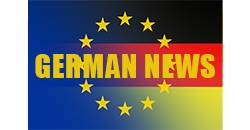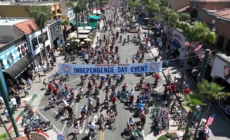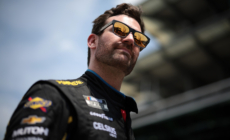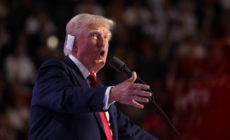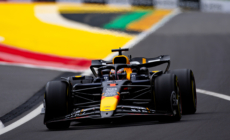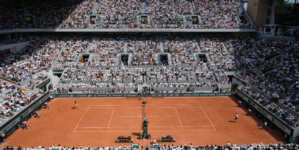-
Mets’ Kodai Senga Exits First Start of Season With Injury - 14 mins ago
-
Fresno County man sentenced for sexually assaulting children, dog - 16 mins ago
-
Doused by Rain, Paris Opens Its Games With a Boat Party on the Seine - 41 mins ago
-
How to Watch Men’s Tennis at the 2024 Paris Olympics: Streams, Schedule - 49 mins ago
-
Photos: Paris is the backdrop for a colorful Olympics opening ceremony - 57 mins ago
-
NASCAR News: This Is Where Corey LaJoie Could Go After Spire Motorsports Exit - about 1 hour ago
-
Bullet or Fragment of One Struck Trump’s Ear, F.B.I. Says - about 1 hour ago
-
Violent demonstration outside L.A. synagogue sparks second lawsuit - 2 hours ago
-
Donald Trump’s Protester Comments Raise Key Issues - 2 hours ago
-
The Obamas Called Kamala Harris After Endorsement. Cameras Rolled. - 2 hours ago
The M.T.A. Wants Marathon Runners to Pay Bridge Tolls, Too
At the start of every New York City Marathon, runners fill the upper and lower tiers of the Verrazzano-Narrows Bridge, an arresting sight that conveys the immensity of the event.
But that picture-postcard moment comes with a hidden price — and now the Metropolitan Transportation Authority wants to collect it.
The M.T.A. has quietly demanded roughly $750,000 a year from the organization that runs the marathon, to make up for the toll revenue that the authority loses when it closes the Verrazzano — North America’s longest suspension bridge — to vehicular traffic, according to interviews and memos reviewed by The New York Times.
The organization, the New York Road Runners, has yet to acquiesce, prompting the M.T.A. to play hardball. The authority initially threatened to restrict runners to the bridge’s shadowy lower deck during the 26.2-mile race in November. But in recent weeks, the M.T.A. slightly relented and said the race could use the upper level if the Road Runners preferred it to the lower level.
Still, the authority said there was no way it would allow both decks to be used without a payment agreement in hand. The marathon has used both decks since 1988.
More than 50,000 runners are expected to participate in this November’s marathon, from amateurs to professionals.
Should those runners be limited to only one level of the bridge, the Road Runners said the organization might have to reduce the number of people accepted into the race, or extend its duration, so that both local streets and the bridge remained closed longer and more participants had to run in the dark.
The dispute pits the M.T.A., whose finances have suffered a post-pandemic commuter decline, against an organization that derives the bulk of its fund-raising from the wildly popular bridge-dependent event — and then uses those funds to support running activities for the rest of the year, many of them free.
The Road Runners is not the only group in the M.T.A.’s sights: In March, the authority also demanded reimbursement from Bike New York, a smaller organization that uses the bridge’s lower deck on the last leg of its Five Boro Bike Tour.
The M.T.A. has told Bike New York that should it not consent, it will no longer be able to use the bridge, effectively rendering its event a four-borough bike tour, according to Bike New York officials.
“New Yorkers love Marathon Sunday, but taxpayers cannot be expected to subsidize a wealthy nongovernment organization like the New York Road Runners to the tune of $750,000,” Catherine Sheridan, the president of M.T.A. Bridges and Tunnels, said in a statement. “The M.T.A. is prepared to continue working toward a final agreement with the N.Y.R.R., provided it leads, over time, to full reimbursement for the lost revenue.”
The authority did not provide a comment about Bike New York.
Rob Simmelkjaer, the chief executive of the Road Runners, pleaded his group’s case in a February letter to Gov. Kathy Hochul, who effectively controls the M.T.A., warning that the start of the marathon was “now in danger.”
Mr. Simmelkjaer pointed out that the marathon was a homegrown institution that draws more than one million spectators and provides substantial economic benefits to New York City.
He also highlighted a certain irony in the M.T.A.’s messaging. Even as the authority has insisted that the marathon is unacceptably costly, it has also praised the race for driving up subway ridership, which boosts the M.T.A.’s fare revenue.
The day after the marathon in November, both the governor and the M.T.A. put out a news release citing those higher ridership numbers: “Marathon runners and spectators alike took the subway to Sunday’s race, accounting for 2,304,683 paid rides, the highest for a Sunday in almost four years,” it read.
But the M.T.A. has been dismissive of the point.
The ridership on that marathon day “was eclipsed one week later by SantaCon,” Ms. Sheridan wrote in a March 22 email to Mr. Simmelkjaer acquired by The Times. (SantaCon is the famously raucous bar crawl featuring revelers in Santa Claus outfits; it actually took place one month after the marathon.)
The Road Runners have indicated a willingness to negotiate, but have thus far resisted agreeing to pay everything the M.T.A. has sought.
Bike New York said its five-borough race was its principal moneymaker, and that it used the funds to offer free cycling lessons and train formerly incarcerated New Yorkers to become mechanics for the city’s bike-share system.
In 2021, for the first time since the five-borough race began in 1977, the M.T.A. required Bike New York to pay for personnel costs related to closing a portion of the bridge. Those costs have risen quickly, from $62,500 in 2021 to $88,000 in 2023. The payments for forgone toll revenue would come on top of that.
Bike New York said it might have to scale back its cycling lessons and training programs should the M.T.A. insist on the toll payments.
The Road Runners also began paying for personnel costs linked to closing the bridge in 2021. Last year, the group was charged $150,000, the organization said.
The M.T.A. has yet to delineate precisely how much Bike New York might owe in forgone toll revenue, according to the organization.
“It’s nothing less than a money grab that will impact the thousands of New Yorkers we serve who are mostly from under-resourced communities,” said Kenneth Podziba, the president and chief executive of Bike New York.
James Parrott, the director of economic and fiscal policy at the New School’s Center for New York City Affairs, questioned the M.T.A.’s logic and timing.
He said that events like the marathon were “part of what make New York, New York,” adding that it was “very narrow-minded” for the M.T.A. to try to recover lost revenues. “The governor and the Legislature decided that the M.T.A. needs revenues, they made a big push to get congestion pricing in place and so on,” Mr. Parrott said. “That’s how M.T.A. revenues are decided, not by them trying to nickel-and-dime constituents in N.Y.C.”
However, Danny Pearlstein, the policy and communications director at Riders Alliance, a transit advocacy group, said that the authority’s stance made some sense, particularly regarding the marathon.
“The New York marathon, it’s not a turkey trot, it’s not a 5K,” Mr. Pearlstein said. “It’s more like an Olympics or a World Cup and it does have a significant impact on the city. And while it brings attention and excitement and revenue, in other ways it also is a moneymaker.”
The tolls on the Verrazzano Bridge subsidize the subway and bus system, which is the main way New Yorkers of all stripes, including those of modest means, get around.
Road Runners “is charging $315 per entry to the marathon in 2024,” Ms. Sheridan wrote in her March email to Mr. Simmelkjaer. “But the marathon sells out irrespective of the entry fee, and you could easily recover proper compensation to the M.T.A. through a slight fee increase, so I’m genuinely confused why you are insisting that less advantaged New Yorkers subsidize the N.Y.R.R. and marathon runners.”
Mr. Parrott was unconvinced.
“They haven’t yet turned on congestion pricing and they’re not doing anything to generate good will among other New Yorkers when they behave like that,” he said, referring to the M.T.A. “That’s not the way to solve their revenue problems.’
